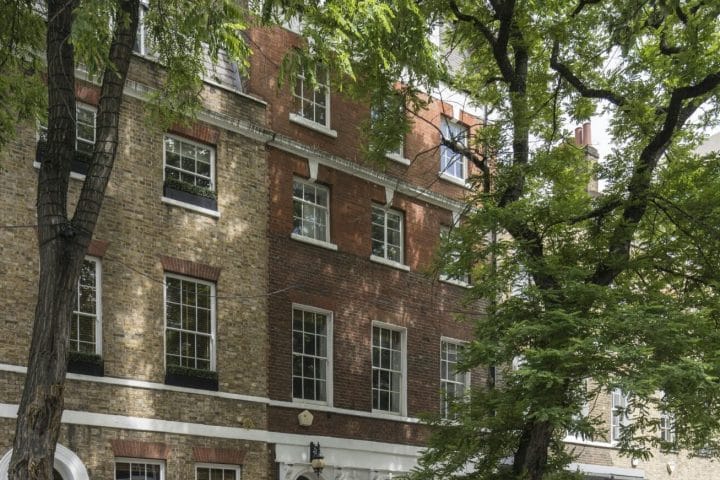We are excited to showcase three artists in our Manhattan gallery with the Contemporary Art Center Ramla, a city in Israel for Jewish and Muslim residents. Anna Hayat and Slava Pirsky present “Rifts, Joints, and Rifts,” while Nahed Abo Alhega Hamza exhibits “Unheimliche, Longing, and the Floor Rag.” All artists share the same themes of being refugees, fears, and anger but from different perspectives.
Anna and Slava are a duo of Israeli Ukrainian artists who closely follow the situation in Ukraine, where their families and friends still reside. What does it mean to leave your home overnight and run? What makes the place you live in a home? These are some of the questions Anna and Slava try to convey with their art. They use a unique and beautiful technique that stitches together war, peace, fear, and hope.
Nahed, a Palestinian artist living in Israel, seeks comfort in memories of her childhood home. She expresses her fears and nightmares about items that symbolize home, such as the curtain from her childhood room and the cloth her mother used to dust the shelves. Like Anna and Slava, Nahed also weaves her past, present, and future with many stories and details that only become visible upon closer inspection.
This exhibit may not be easy to digest, but diving into Anna, Slava, and Nahed’s world may give you pause while allowing you to find a ray of hope. Whether it makes you more optimistic or pessimistic, the exhibit will make you feel something; those emotions matter most.
Supported by the Laurie M. Tisch Illumination Fund and the New York City Department of Cultural Affairs, this collaborative showcase invites visitors to engage with the rich narratives woven into the fabric of art.
The exhibit will open on September 7, but I am happy to give you a first look the day before, September 6.
About the Exhibits
Unheimliche, Longing, and the Floor Rag
Artist: Nahed Abo Alhega Hamza
Curator: Dr. Smadar Sheffi
Artist Nahed Abo Alhega Hamza draws on domestic textiles (floor rags, curtains, sheets) associated with cleanliness and the intimacy of a physically and metaphorically cushioned space. A friendly home, the object of longing, embodying family memories, may become an arena for violence and threat, evoking what Freud termed unheimliche, the “uncanny.”
Abo Alhega Hamza’s works present an encounter between home as a safe place and a site of fear. The body of work exhibited evolved after the artist’s mother passed away in 2019, sparking a re-reading of “home” and its components. Her intricate drawings signify our complicated relationships with objects and their symbolic meanings, corresponding with art and ideas from Dada to Surrealism to science fiction. Strong emotions, including pain and anxiety, flow into the large black and blue ink portrait, which is cut out and embroidered on red fabric. Comprising drawings of hands, architectural details, intertwined muscles, plants, bones, and flowing water, it has art historical associations to Arcimboldo and Georg Grosz, among others.
Works on handkerchiefs from her parents’ wedding preserve the folds as a grid of memories, hopes, innocence, and promise, embodying movement, vulnerability, and vitality, with a streak of the uncanny emanating from her oeuvre.
Rifts, Joints, and Rifts
Artists: Anna Hayat + Slava Pirsky
Curator: Dr. Smadar Sheffi
Anna Hayat and Slava Pirsky’s photographs are exquisite. Most are printed on fabric, hand-sewn, and embroidered. This is the first time the duo exhibits sewn images simultaneously joining and breaking apart. They are almost corporeal, the stitches throbbing with pain like a wounded body.
Time becomes matter, an additional element in the photographs comprising past and present, its density evident in the works with flowers. Hayat and Pirsky distill clichéd images and objects, then reilluminate them in a continuous dialogue between photography and painting.
The discourse on time is a central motif of their works. The photographs are shot on a large format view camera using outdated Polaroid film, whose chemicals leave random stains on the image. Solarization creates further uncontrolled reactions; chance becomes part of their aesthetic. Hayat and Pirsky integrate these chance reactions with controlled, precise photography in the tradition of early 20th-century American photography, which is intriguing when combined with the unexpected.
Sewing the photographs, a new process for Hayat and Pirsky, began after encountering kintsugi, the Japanese art of “golden repair” (of broken pottery) without concealing flaws. The works were made while the artists closely followed developments in the war in Ukraine, fearful for the lives of friends and relatives. The many rifts in the works demonstrate a sense of urgency and injury.
ABOUT THE MARLENE MEYERSON JCC MANHATTAN
Together with its community, the Marlene Meyerson JCC Manhattan creates opportunities for people to connect, grow, and learn within an ever-changing Jewish landscape. Located on 76th Street and Amsterdam Avenue, the JCC is a vibrant nonprofit community center on the Upper West Side. It also presents a robust slate of virtual programming, serving an even wider community. The JCC serves over 30,000 people annually through 1,200 programs each season that educate, inspire, and transform participants’ minds, bodies, and spirits. Since its inception, the JCC has been committed to serving the community by offering programs, classes, and events that reach beyond neighborhood boundaries, reaching people at all stages of their lives. Learn more at mmjccm.org.
Marlene Meyerson JCC Manhattan
334 Amsterdam Ave at, W 76th St, New York, NY 10023, United States













